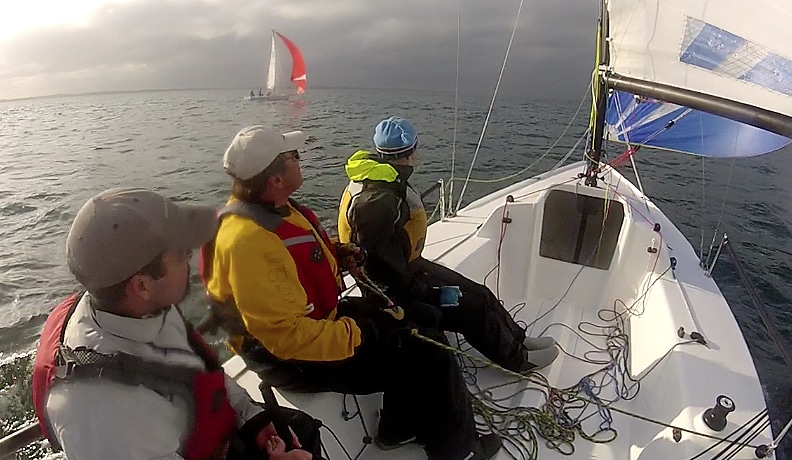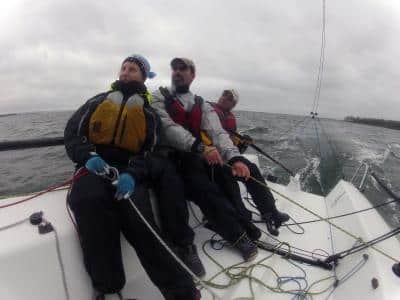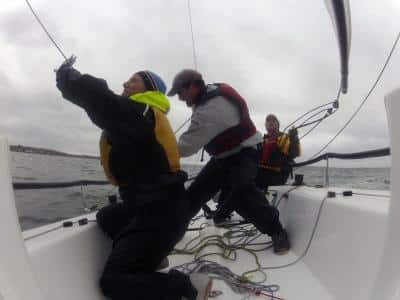
J/70
Three weeks ago I walked into the resin-fumed atmosphere of Joe DaPonte’s “shop,” CCF Composites in Bristol, R.I., where the J/70 prototype sat in its cradle, the hull and deck having been wed only hours earlier.
“It’s coming along nicely,” said Jeff Johnstone, J/Boats’ unflappable president. Behind his wire rimmed glasses there was twinkle in his eye, and he maintained a smug grin as he described his brother Al’s new addition to the family. “It’s taken a lot to get to this point. We can’t wait to get it sailing.”
Over the next several weeks the finish work moved at a rapid pace, with the ebb and flow of vendors and anyone who had a stake in the project: the hardware guys from Harken and Ronstan, the mast builders from Southern Spars, the custom fabricator with the compression post and keel-lift crane. Then came the sailmakers to bend on their Dacron in the parking lot outside CCF.
All the bits and pieces came together as planned, and voila, just like that, by mid-March Johnstone and his team unceremoniously ramp-launched the 22.5-footer into Narragansett Bay, baptizing their first small keelboat since the J/22 in—gasp—1983.
It’s anyone’s guess as to how the sailing world will take to another twenty-something one-design, but as is standard protocol for J/Boats, this one, too, has been thought over and thought over again, with regard to its niche in the market, the timing of its arrival, its cost, and how best to get everyone’s attention.
For the past two weeks Johnstone has essentially relocated his office to a vacant Bristol Harbor, sailing Hulls 1 and 2, getting equipment vendors and dealers onboard and allowing sailmakers from both North Sails and Quantum Sail Design Group to develop their respective three-sail inventories. This week Johnstone accommodated the sailing media, yours truly included, along with SW‘s web editor Meredith Powlison. We jumped onboard for an afternoon session with Quantum’s Tim Healy and Kerry Klingler. It was part demo sail, part fact-finding mission for the sailmakers.
At the dock, the boat was remarkably stable as we clamored around it rigging sails and sheets. The jib is zip-luffed onto the headstay and furled on a Harken under-deck furling unit designed specifically for the boat, bringing the jib foot right down to the deck. The jib has a small amount of “positive roach” up high and the mainsail, which is more rounded roach than square top, is high aspect, and definitely on the flatter side. The deck-stepped mast looked to be a stiff and robust section, and the single set of long, swept spreaders makes the whole package appear fairly simple.
After a quick rig we were off and sailing in a puffy 10- to 15-knot spring southerly. When I slid into the driver’s seat, grabbed the tiller, and sheeted in another click on the floor-mounted ratchet block, my immediate impression was the responsiveness of the rudder: micromovements gave instant results. And when I found that groove somewhere between high and pinchy and bow-down fast, the boat came alive. With the three others sitting casually, legs out, I let the tiller extension float above my open hand, and the helm remained balanced, the boat practically sailed by itself. When a puff would hit, a small amount of mainsheet ease kept it tracking. J/Boats tend to focus first on having good upwind traits, and the J/70 is no exception.
It turned swiftly through the tacks, even without any attempt to roll, and because of the narrowness of the cockpit, the high boom, and plenty of space behind the traveler, I only had to take two steps to go from sitting to sitting. It was a very natural flow, and I never felt any tendency of being tossed off-balance mid-tack.
With three bodies hiking under the single, low lifeline, it was a little challenging for the jib trimmer (sitting one forward of the helm) to squeeze between the winch and the next crewmember forward. There were no winch-handle pockets or handles onboard (yet), but I presume a good tacking technique would go much like a J/24 where the trimmer gets the gross trim (cross-sheeting) and pops the handle in while getting to the rail, leaving the final grind to the driver. Boathandling mechanics will be worked out in no time, and I’m sure Klingler, who when trimming, half-jokingly experimented with his own technique of coming in off the rail (think backwards, head-first, Navy SEAL-style roll), will come up with something different.

During our pre-sail briefing, Johnstone said they’d already experimented with launching/dousing the spinnaker through the small forward hatch in light air, and through the companionway as well. We used the latter technique and the mechanics were straightforward: the forward person launches the retractable pole and feeds the kite out of the companionway. The trimmer gets the tack to the pole and then goes to the halyard.
On the run, in the 15-knot puffs we had, the boat was quick to accelerate, responsive to weight and helm movements, and incredibly stable. It was a remarkably dry ride. As it was during tacks, the transition from jibe to jibe was quick, and it only took a few seconds for the kite to fill, get the flow going again, and get ‘er back up to speed. All good.

The companionway douse was straightforward as well, and this is where crew selection would benefit having a smaller, more nimble person who is able to get low and forward near the shrouds for leeward drop. The clew is high and the foot fairly short, so shrimping incidences shouldn’t be common. We did not attempt a Mexican, but I’m sure it would be the better move anyway.
The ideal number of bodies, and the official racing crew weight, is still an ongoing discussion among all parties involved–and Johnstone preferred to have more time in the boat before nailing anything specific–but our sense was that somewhere in the vicinity of 600 to 620 pounds would be the likely range. Three-up would keep everyone entertained and make getting on and off the rail more fluid, but if I had it my way, I’d want three athletic 170-pounders and one petite or youth crew in the forward position.
While the prototype was good enough to be enjoyed to its full potential for our demo sail, the “real” boats are underway at CCF, and the plan, according to Johnstone, is to have the first finished boats sailing by mid-April. The New York YC’s Invitational Cup Qualifier regatta in September will be using J/70s (and Sonars). That’s an unprecedented fleet spark, but I’m told the boats will then scatter to dealers and eager owners around the country. Two demo boats will be available in Rhode Island throughout the summer, and Johnstone said initial plans for the class are to hit the major winter regatta venues in 2013 (i.e., Key West, Miami, and Charleston) before encouraging owners to take their regattas to more offbeat venues, particularly locations served primarily by launch ramps. Which makes perfect sense. With its first-ever ramp launch-able boat, competitively priced at around $40K (base price; fleet pricing at $45K), J/Boats finally has something to extend its reach to places where it’s never been before.









